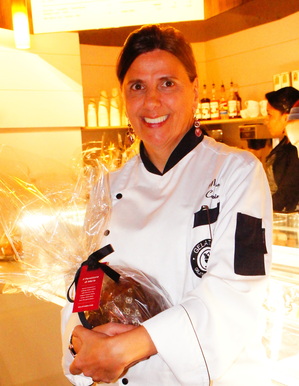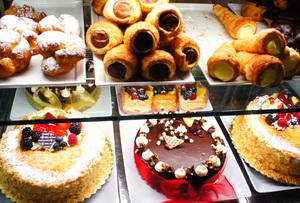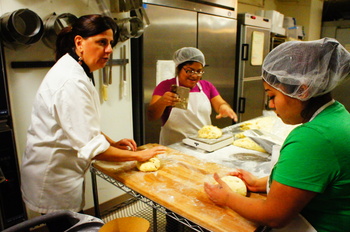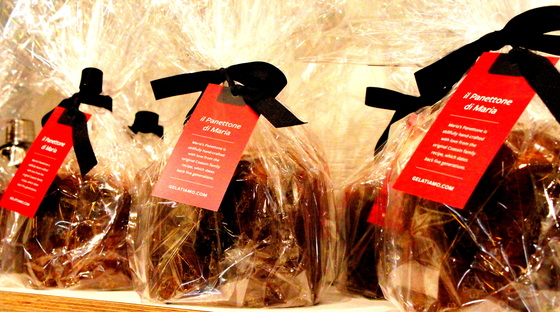You can buy an industrial panettone for under ten bucks, something made in a factory last summer that sits on the supermarket shelf waiting for December. (It will taste like sweetened sawdust.) You can try to make your own at home, but it takes 27 hours, start to finish, waiting for the yeast to rise, and rise again. You have to add spendthrift amounts of butter and egg yolks; you have to watch times and temperatures like a hawk, and when it comes out of the oven it's still so delicate that it will collapse like a soufflé unless you hang it upside down, like a bat, on a skewer. Then, once it cools, it still has to "mature" for about a week so that its aromatic ingredients (the citrus, the rum, the vanilla) can develop their full flavors and fragrances.
 Maria Coassin, the owner of Gelatiamo in downtown Seattle, makes about 1,200 panettone every year, essentially by hand, with good cheer and artisanal dedication. She grew up in a family of bakers in the small town of Maniago, just over 10,000 people, midway between Venice and Trieste in northeastern Italy and known throughout Europe for the local industry: knife-making. The Giulian Alps tower over the flood plains of the Po River. The cows are milked for cheese, and the pigs, fed on the whey, become prosciutto. The mountain streams provide a ready and reliable source of energy to mill grain, stoke forges, and turn lathes. To manufacture highly sophisticated automobiles, for example, you need a work force familiar with precision tools, and most of Italy's racing cars (Maserati, Lamborghini, etc.) are built in the region. But those workers need to eat, too, and the Coassin Bakery has prospered for five generations. With loving parents and five older brothers, Maria was well looked-after, but she realized early-on that the family business was limiting. Pastries and gelato, she knew even then, would be her field. Not yet 20, she married an American airman stationed at the nearby Aviano Air Force Base, moved to California, and took a job with McDonald's so she could learn English and become versed in American business practices. When her husband retired from the military a few years later, she'd climbed the corporate ladder from mopping floors and washing dishes to assistant manager. She was ready to set out on her own, but didn't want to stay in California. They flipped a coin: Seattle or Atlanta.
Maria Coassin, the owner of Gelatiamo in downtown Seattle, makes about 1,200 panettone every year, essentially by hand, with good cheer and artisanal dedication. She grew up in a family of bakers in the small town of Maniago, just over 10,000 people, midway between Venice and Trieste in northeastern Italy and known throughout Europe for the local industry: knife-making. The Giulian Alps tower over the flood plains of the Po River. The cows are milked for cheese, and the pigs, fed on the whey, become prosciutto. The mountain streams provide a ready and reliable source of energy to mill grain, stoke forges, and turn lathes. To manufacture highly sophisticated automobiles, for example, you need a work force familiar with precision tools, and most of Italy's racing cars (Maserati, Lamborghini, etc.) are built in the region. But those workers need to eat, too, and the Coassin Bakery has prospered for five generations. With loving parents and five older brothers, Maria was well looked-after, but she realized early-on that the family business was limiting. Pastries and gelato, she knew even then, would be her field. Not yet 20, she married an American airman stationed at the nearby Aviano Air Force Base, moved to California, and took a job with McDonald's so she could learn English and become versed in American business practices. When her husband retired from the military a few years later, she'd climbed the corporate ladder from mopping floors and washing dishes to assistant manager. She was ready to set out on her own, but didn't want to stay in California. They flipped a coin: Seattle or Atlanta.
She signed on with an educational supply company in Seattle while she looked for a spot to open her own business. What she found was "Third & Hell," the then-hardscrabble corner at Third & Union across from Benaroya Hall (announced but not yet under construction) and the neglected Mann building that Rick and Ann Yoder would buy and restore, moving their popular pan-Asian cafe, Wild Ginger, from Western Avenue into the upstairs space, and creating a music venue, the Triple Door, below. Brian Garrity had just opened Procopio, Seattle's first gelateria, in the Pike Street Hillclimb. Dany Mitchell followed with Gepetto in Pioneer Square. By then, Coassin had a name ready to go: a made-up word that's the Italian equivalent of I Love Sushi: "Gelato Ti Amo," or Gelatiamo. (To an Italian speaker, it sounds as if you're saying "Let's go eat gelato.")
Coassin had almost no financing, however, so she cashed out her share of the family bakery business; it came to $200,000. Her father pitched in another $50,000 to help her buy equipment. (Reminder: this was serious money 20 years ago.) In fact, he came to visit the first year, in 1996. "What can I do to help?" he would ask. It was a cold winter, not much demand for that sexy but little-known Italian newcomer, gelato. (Lots of customers thought it was cream cheese.) So Coassin's dad started making panettone.
The name, by the way, is an Italian suffix, "-one" (OH-nay), something bigger, grander. So polpetta, meatball; polpettone, meatloaf. Minestra, soup; minetsrone, fancy soup (lots of vegetables). Pane, bread; panettone, fancy bread for the holidays. More brioche than fruitcake, not dense like a German Stollen, but bread-y, sweet, yeasty, with plenty of run-soaked raisins, and candied orange zest and lemon bits.
 In addition to the holiday panettone, Coassin added pastries to her repertoire, and Gelatiamo took on the character of a Viennese cafe. Gelato is fine for maybe six months of the year in a cool climate like Seattle; cakes, cookies, and coffee are what tide you over. She expanded her workshop in the basement of the Vance Building several times to accommodate high-tech equipment as she increased her gelato production to service wholesale accounts like Pagliacci pizza parlors. That kitchen today includes a food-grade pasteurizing machine to satisfy the Department of Agriculture's byzantine food-safety regulations, several mixing machines, two half-size, Moffat turbo-fan convection ovens, a walk-in fridge, and a couple of freezers. Right now she uses two Italian-made Bravo gelato making machines, automatic models that quickly pasteurize the mixture--a requirement since Coassin makes her gelato from scratch--before batch-freezing it. Unlike the practice of her competitors, she doesn't use commercial mixes. "I don't compromise, though," she told me. "If ingredients cost more, like eggs or hazelnuts, I pay what they cost, but I don't raise my prices."
In addition to the holiday panettone, Coassin added pastries to her repertoire, and Gelatiamo took on the character of a Viennese cafe. Gelato is fine for maybe six months of the year in a cool climate like Seattle; cakes, cookies, and coffee are what tide you over. She expanded her workshop in the basement of the Vance Building several times to accommodate high-tech equipment as she increased her gelato production to service wholesale accounts like Pagliacci pizza parlors. That kitchen today includes a food-grade pasteurizing machine to satisfy the Department of Agriculture's byzantine food-safety regulations, several mixing machines, two half-size, Moffat turbo-fan convection ovens, a walk-in fridge, and a couple of freezers. Right now she uses two Italian-made Bravo gelato making machines, automatic models that quickly pasteurize the mixture--a requirement since Coassin makes her gelato from scratch--before batch-freezing it. Unlike the practice of her competitors, she doesn't use commercial mixes. "I don't compromise, though," she told me. "If ingredients cost more, like eggs or hazelnuts, I pay what they cost, but I don't raise my prices."
 Over the years she has built up a team of 20. Assisted by longtime employees Gabi Lopez and Elisa Jimenez on a recent night, Coassin efficiently divided the totes filled with twice-risen panettone dough into 520-gram portions; the women quickly massaged them into smooth balls that they lowered into paper molds. It's the only time in the process that the dough is touched by human hands.
Over the years she has built up a team of 20. Assisted by longtime employees Gabi Lopez and Elisa Jimenez on a recent night, Coassin efficiently divided the totes filled with twice-risen panettone dough into 520-gram portions; the women quickly massaged them into smooth balls that they lowered into paper molds. It's the only time in the process that the dough is touched by human hands.
In those two small ovens, Coassin can only bake 16 panettones at a time, but she gets a lot of satisfaction from knowing that her brothers in Italy are doing exactly the same thing at the same hour. FaceTime conversations are not unheard of. And after all that effort, 1,200 one-pound loaves of panettone, priced at $20 apiece. (A special treat, Gelatiamo's panettone filled with zabaglione-flavored gelato, is sometimes available by the slice.) Add it up, and it might seem barely worth the effort. But it's a fifth-generation thing in Maniago, and a 20-year Seattle tradition now, and Coassin won't give it up.

Leave a comment